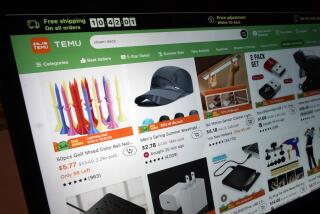Exporting presents opportunities and challenges for small businesses
Exporting can be daunting for small-business owners, but with the domestic economy still slow, it’s tempting.
Some small businesses have had significant success in expanding to overseas markets. Orly International Inc., which makes nail care products, is a 105-employee firm in Van Nuys. Its foreign sales growth now outpaces the annual increases in domestic sales.
“We just have seen such a growth opportunity in our export business that we have accelerated that emphasis to build more export markets,” said Bob Hobe, Orly’s vice president for international business development.
The company exports to 82 countries and is looking toward Latin America for further expansion. Hobe cited Brazil, Chile and Argentina as examples of countries that “have had continuous growth even in the global recession.”
The federal government is hoping more companies get into exporting. Last year, President Obama set a goal to double the nation’s exports by 2015 as a way to increase U.S. jobs. In California, exports of merchandise climbed 19.3% in 2010 to $143.3 billion, according to a recent U.S. Commerce Department report. That is almost back to pre-recession levels and accounts for about 11.2% of merchandise exports nationwide, according to Beacon Economics.
Most of California’s exporters are small and don’t venture too far afield — Mexico and Canada are the top two countries for the state’s exports.
“There is a lot of potential to go beyond our little regional corridor here, beyond Canada and Mexico,” said Richard Swanson, director of the Pacific South region for the U.S. Commercial Service, an arm of the Commerce Department.
But small-business owners who want to get into exporting face a number of obstacles, especially if they want to move beyond North America. They have to find trusted overseas partners to handle distribution. They have to deal with shipping logistics and sort out sometimes-complicated import duties.
Also, some businesses fear their intellectual property will be stolen if they sell a product overseas. This issue has come up particularly in dealings with China.
“If there were no constraints, if there were no challenges and we knew no one would rip us off, then everyone would be exporting,” said Suresh Kumar, assistant secretary for trade promotion at the Commercial Service.
Among the Commercial Service’s resources are industry-specific counseling, trade missions and conferences for companies that want to export to new markets.
Information is available online at https://www.export.gov and at the Commercial Service’s export assistance centers across the country, including in downtown Los Angeles, West Los Angeles, Newport Beach, Ontario and Ventura.
Orly International has used the agency’s Gold Key Service to find prescreened distribution partners, Hobe said. The service costs $350 to $700 for businesses that have fewer than 500 employees.
Chuck Mirjahangir, principal at Mirjahangir Engineering of Huntington Beach, attended a trade show in Hong Kong in the fall with the help of a federally funded program.
“When the market started going a little bit south here, I started to explore the opportunity of going overseas,” said Mirjahangir, whose company specializes in green energy systems.
He has had no overseas sales but is in talks with several potential clients.
At the state level, there are a number of Centers for International Trade Development, down from 13 a year ago. The center at El Camino College, which developed the green-technology export program (www.greenexport.org), no longer gets state funding but still operates a wide range of services.
Director Maurice Kogon has developed a seven-step export program that covers training, marketing, promotion, distribution and other matters.
He’s recruiting companies for a trip to a green-technology trade show in Beijing.
“Some portion of the 85% of manufacturers who don’t export, would if we could get to them,” Kogon said. “Renewable energy equipment is a sweet spot.”






